Transforming Buddhist Pilgrimage to Japan
Encourages Zen Students About Practice Here
Written by: Nomon Tim Burnett
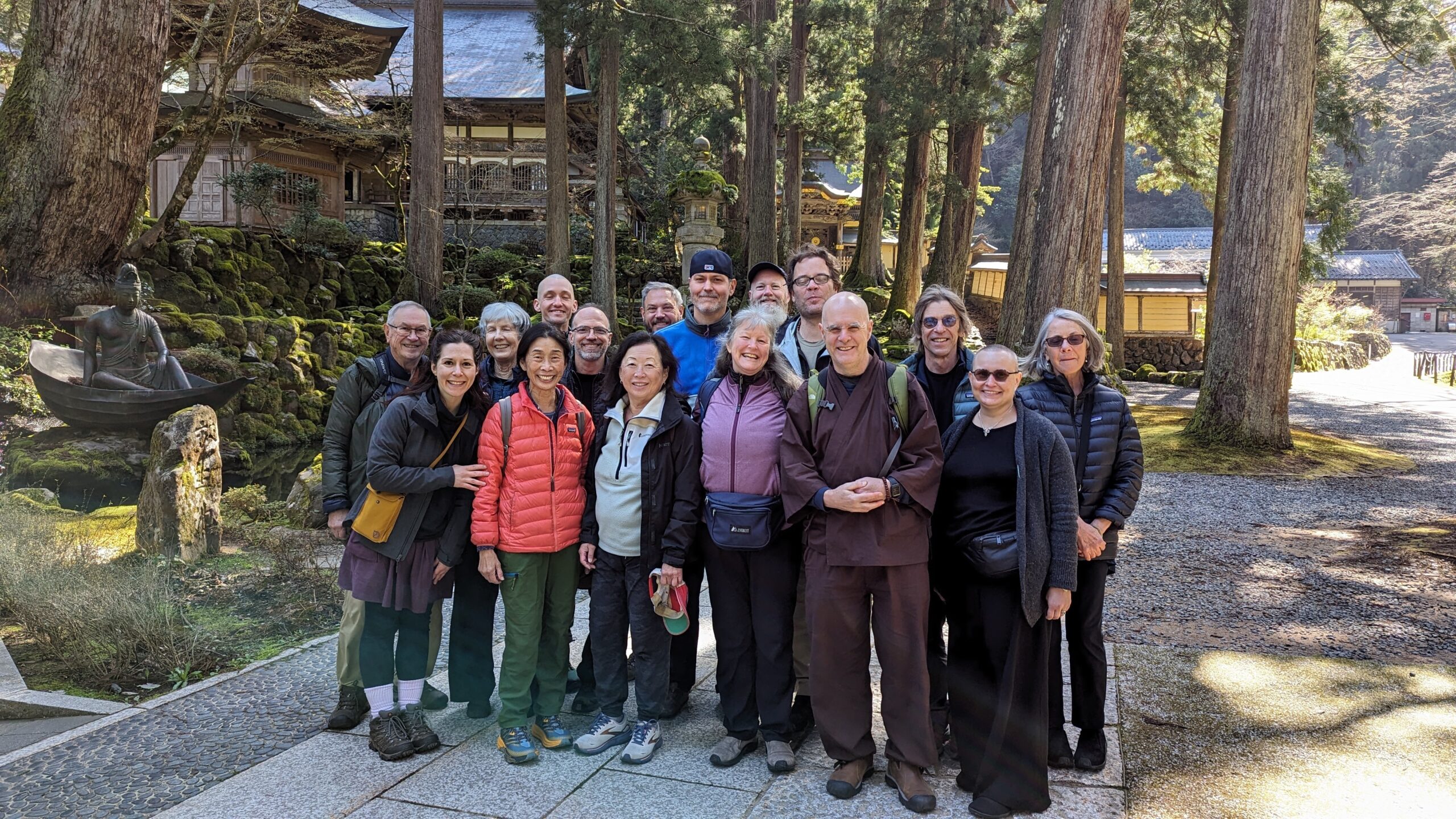
The Red Cedar Zen pilgrims at Eihei-ji monastery, founded by Eihei Dogen in 1241.
Eighteen Bellingham Zen students went on a powerful pilgrimage to Japan in April, where the tremendous depth and concerning decline in Zen Buddhism, inspired us to persevere in practice at home.
Our group from the Red Cedar Zen Community spent two weeks in Japan visiting the temples, landscapes and people, who have created and tended our Sōtō Zen tradition for nearly 800 years.
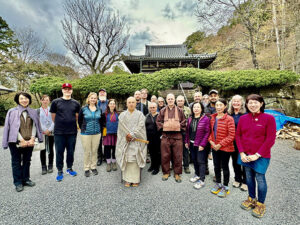
What we discovered, inspires us deeply to keep going. It inspires us to keep practicing, to finish building our new temple in Bellingham, Washington, to support our members, and to keep welcoming others with an interest in Zen practice.
The different Japanese Buddhist traditions have much in common, and during this trip we visited several different Buddhisms: Rinzai Zen, Tendai, and our own tradition of Sōtō Zen. The ever-present shrines of the Shinto religion were also inspiring, and fascinated our traveling band as we journeyed around the Kansai region of the main island of Honshu.
Depth
We spent a day with two impressive monks, and learned about the incredible depth of their respective practices.
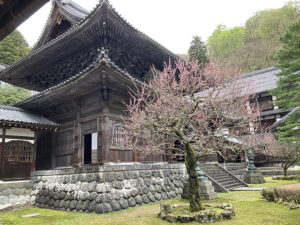
First we met 48-year-old Tendai Buddhist monk Mitsunaga Endo, who is now known as Dai Ajari-sama. He is one of just 51 monks in history to complete a practice known as Kaihogyo, meaning “circling the mountain.” This is the practice of the famed marathon monks of Mt. Hiei, above Kyoto.
I was familiar with this practice from reading “The Marathon Monks of Mount Hiei,” a large-format book by John Stevens. Practitioners of Kaihogyo complete a seven-year practice, centered on a nightly running ritual on the trails up, down and around sacred Hiei Mountain.
The kaihogyo practitioner, called a gyōja, gets up at 2 a.m. for 100 day-stretches, to run a 25-mile circuit in traditional garb of white robes, straw sandals, a staff, and an oil lamp to see his way. The route includes more than 100 ritual stops at shrines and sacred spots to chant, do mudras, and make offerings.
Each day of this needs to be completed by the time the temple starts its regular practice early in the morning, which the gyōja is expected to participate in just like the rest of the monks. These nightly runs get longer each year.
The whole process culminates in an intense meditation retreat called Dōiri, “Entering the Temple.”
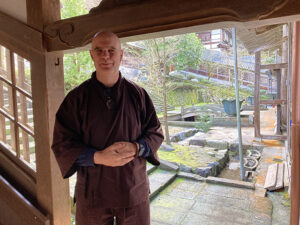
For nine days the gyōja recites the mantra of the protector of the dharma, who is named Fudo Myoo, and who is the “patron saint” of Kaihogyo. And that’s it. There are no other practices, no sleeping or rest periods, no food, not even water. Two support monks sit on either side of the gyōja the entire time, to help the practitioner remain upright.
We asked Dai Ajari-sama (his title is Japanese for “great arhat” – or awakened one) if he ever thought about giving up, and how he survived this practice. He said the thought of giving up never occurred to him, and that the only way he could understand his ability to do it all was that he relied on the power of Fudo Myoo.
It became clear to us he was not a great athlete, although by any measure he was that. During one of the later years of his practice he ran nearly 50 miles night and day, every day for 100 days. This was a deeply committed religious practitioner, whose faith in his way became unshakable through this rigorous practice.
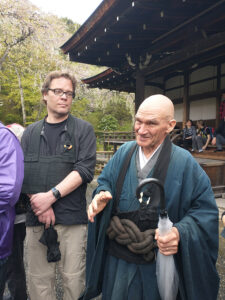
A few days later we had the opportunity to spend the day with Yuho Tom Kirschner. Kirschner is one of few Westerners to complete the entire Rinzai Zen monastic curriculum. This included appropriate responses to hundreds of koans, the traditional Zen puzzle-stories of the awakened life, with those responses presented in classical Japanese.
Kirschner over several several years sat, slept and ate at several sodos, which refers to monks’ halls, always on the same tatami mat. In several of the great Rinzai Zen training centers of Kyoto, he lived in close company with 20 to 30 other monks. Each training day went from 3 a.m. to 11 p.m., with a continuous flow of meditation, ritual, cleaning, temple chores, and more meditation.
While most of his fellow monks were doing this training in preparation for positions working in Rinzai temples, Kirschner did this practice solely out of personal interest. These days Kirschner and his wife live in a small gatehouse at Tenryu-ji temple, where he serves as a part-time tour guide for visiting groups.
We found both Dai Ajari-sama and Kirschner-san humble, kind and curious. Both are living simple lives of practice, and were remarkably welcoming and kind with our visiting band. Neither has received high accolades or important positions or riches for their remarkable accomplishments in practice. Both were curious to learn about us, and welcomed us into their worlds with openness and delight.
Decline
However, the Buddhist schools of both of these impressive monks are in decline.
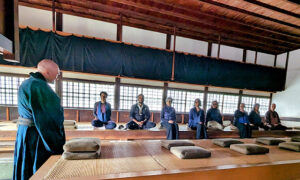
All of Tendai Buddhism is a school in decline, after circumstances forced a huge pulling back. Tendai was founded in the year 806, and dominated Japanese Buddhism for the next 500 years.
Then with the rise of Zen and the many Pure Land schools in the 13th century, Tendai Buddhists lost most of their influence. They then pulled back to their one sacred mountain of Mt. Hiei, where they’ve remained for the last 700 years or so, keeping their tradition alive.
Meanwhile the Zen school that displaced Tendai Buddhism 700 years ago, is also in decline. Kirschner said the major Rinzai Zen temple where he trained has only seven monks these days, down from 25 when he trained 20 years ago. The buildings were constructed for 100 monks, but demand has dropped to just seven in a century!

On the Sōtō Zen side of the equation, our visit to head training monastery Eihei-ji told a similar story of decline. Where Rinzai was the Zen of the elite in the capital, Sōtō was spread across the countryside with many smaller temples, plus a few training monasteries to supply those village temples with priests.
Our hosts shared that while the 150 monks we saw that morning chanting in the Buddha Hall were an impressive sight, 250 monks were there when he was training 10 years earlier. Across Japan, Sōtō Zen has 14,000 temples but only 7,000 priests to serve them, and the disparity is only increasing as fewer new monks come up to replace those who retire.
Inspiration
We left Japan deeply inspired to continue our efforts to offer Sōtō Zen practice in Bellingham. We felt validated about the ways we’re continuing some of the traditional forms and overall feeling of the practice, and also about the innovations and changes that have happened in the West.
If you want to join a group for zazen meditation, you’re better off going to Bellingham than to Kyoto! In Kyoto only specialized monks do zazen, while everyone else visits the temples to admire the impressive buildings and gardens, more than to practice.
Nomon Tim Burnett has been a student of Zoketsu Norman Fischer since 1987, when he was a resident at San Francisco Zen Center’s Green Gulch Farm. After sitting practice periods at Green Gulch and Tassajara Zen Monastery, Tim helped found the Bellingham Zen Practice Group in 1991. Tim was ordained as a Zen priest by Fischer in 2000, received dharma transmission in 2011, and was installed as guiding teacher of the sangha in 2017.
